Polina Bayvel
Ultrawideband optical fibre throughput in the presence of total optical power constraints from C to OESCLU spectral bands
Jul 19, 2024



Abstract:Using a recently developed fast integral ultrawideband Gaussian noise model, we quantify the achievable throughput under total optical power constraints for systems ranging from C-band to fully populated OESCLU bands using optimum launch powers, showing conditions when expanding bandwidth provides no additional throughput.
Optimising O-to-U Band Transmission Using Fast ISRS Gaussian Noise Numerical Integral Model
Jan 31, 2024



Abstract:We model the transmission of ultrawideband (UWB) signals, including wavelength-dependent fibre parameters: dispersion, nonlinear coefficient and effective fibre core area. To that end, the inter-channel stimulated Raman scattering Gaussian noise (ISRS GN) integral model is extended to include these parameters. The integrals involved in this frequency-domain model are numerically solved in hyperbolic coordinates using a Riemann sum. The model implementation is designed to work on parallel graphics processing units (GPUs) and is optimised for fast computational time. The model is valid for Gaussian-distributed signals and is compared with the split-step Fourier method (SSFM), for transmission over standard single-mode fibre (SSMF) in the O-band (wavelengths around the zero-dispersion wavelength), showing reasonable agreement. Further, we demonstrated SNR evaluation over an 80 km SSFM single-span transmission using 589$\times$96 GBaud channels, corresponding to almost 59 THz optical bandwidth, fully populating the O, E, S, C, L and U bands (1260$-$1675 nm). The SNR evaluation is completed in just 3.6 seconds using four Nvidia V100 16GB PCIe GPUs. Finally, we used this model to find the optimum launch power profile for this system achieving 747 Tbps of potential throughput over 80 km fibre and demonstrating its suitability for UWB optimisation routines.
Dual band wireless transmission over 75-150GHz millimeter wave carriers using frequency-locked laser pairs
Oct 27, 2023

Abstract:We generate and transmit 75-GHz-bandwidth OFDM signals over the air using three mutually frequency-locked lasers, achieving minimal frequency gap between the wireless W and D bands using optical-assisted approaches, resulting in 173.5 Gb/s detected capacity.
High-Cardinality Geometrical Constellation Shaping for the Nonlinear Fibre Channel
May 09, 2022



Abstract:This paper presents design methods for highly efficient optimisation of geometrically shaped constellations to maximise data throughput in optical communications. It describes methods to analytically calculate the information-theoretical loss and the gradient of this loss as a function of the input constellation shape. The gradients of the \ac{MI} and \ac{GMI} are critical to the optimisation of geometrically-shaped constellations. It presents the analytical derivative of the achievable information rate metrics with respect to the input constellation. The proposed method allows for improved design of higher cardinality and higher-dimensional constellations for optimising both linear and nonlinear fibre transmission throughput. Near-capacity achieving constellations with up to 8192 points for both 2 and 4 dimensions, with generalised mutual information (GMI) within 0.06 bit/2Dsymbol of additive white Gaussian noise channel (AWGN) capacity, are presented. Additionally, a design algorithm reducing the design computation time from days to minutes is introduced, allowing the presentation of optimised constellations for both linear AWGN and nonlinear fibre channels for a wide range of signal-to-noise ratios.
Experimental Investigation of Deep Learning for Digital Signal Processing in Short Reach Optical Fiber Communications
May 18, 2020
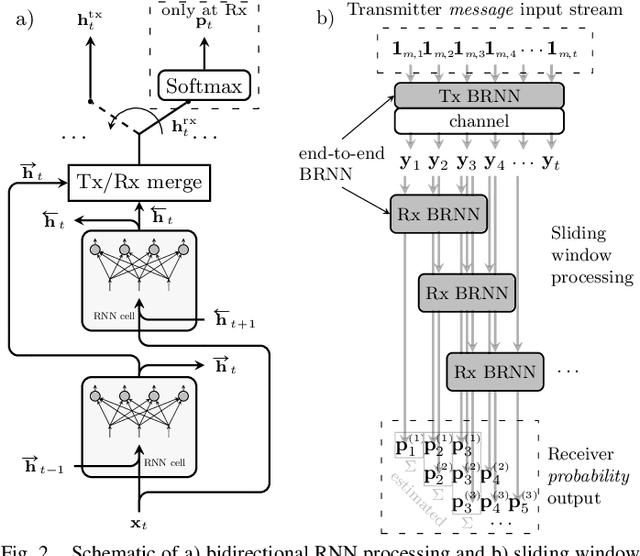
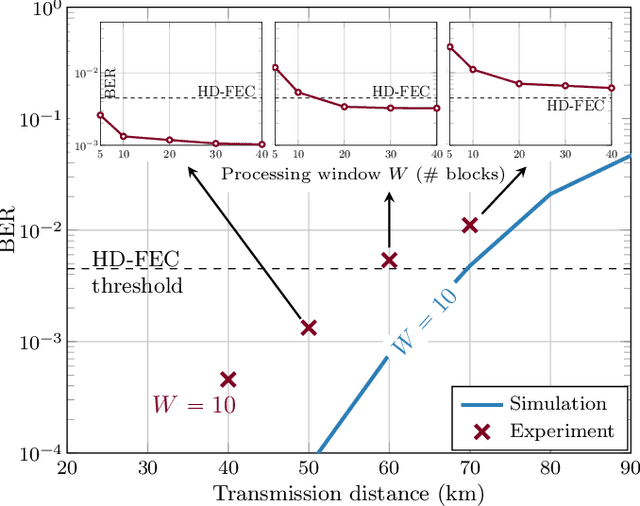
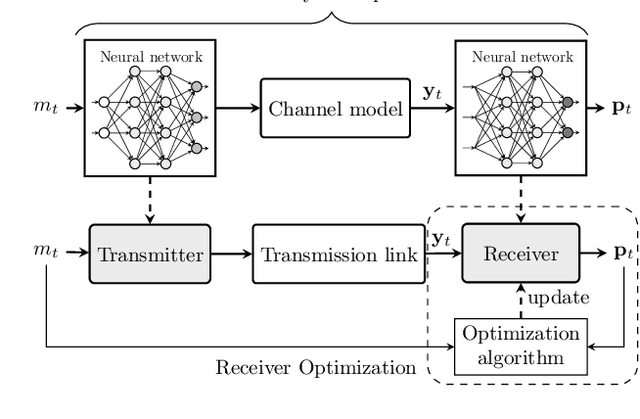
Abstract:We investigate methods for experimental performance enhancement of auto-encoders based on a recurrent neural network (RNN) for communication over dispersive nonlinear channels. In particular, our focus is on the recently proposed sliding window bidirectional RNN (SBRNN) optical fiber autoencoder. We show that adjusting the processing window in the sequence estimation algorithm at the receiver improves the reach of simple systems trained on a channel model and applied "as is" to the transmission link. Moreover, the collected experimental data was used to optimize the receiver neural network parameters, allowing to transmit 42 Gb/s with bit-error rate (BER) below the 6.7% hard-decision forward error correction threshold at distances up to 70km as well as 84 Gb/s at 20 km. The investigation of digital signal processing (DSP) optimized on experimental data is extended to pulse amplitude modulation with receivers performing sliding window sequence estimation using a feed-forward or a recurrent neural network as well as classical nonlinear Volterra equalization. Our results show that, for fixed algorithm memory, the DSP based on deep learning achieves an improved BER performance, allowing to increase the reach of the system.
Optical Fiber Communication Systems Based on End-to-End Deep Learning
May 18, 2020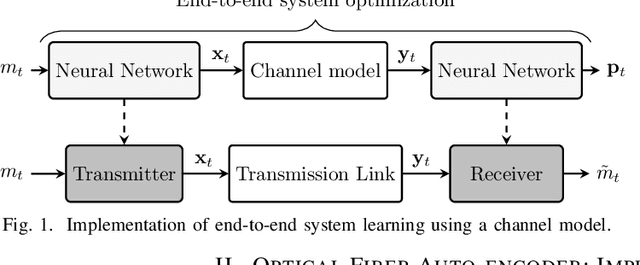
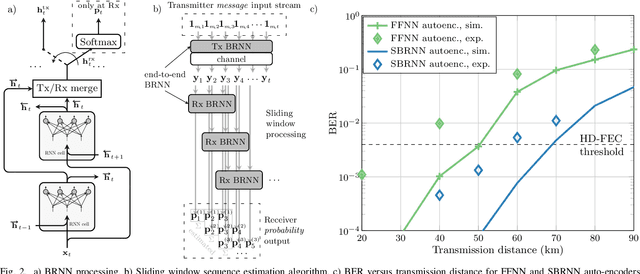
Abstract:We investigate end-to-end optimized optical transmission systems based on feedforward or bidirectional recurrent neural networks (BRNN) and deep learning. In particular, we report the first experimental demonstration of a BRNN auto-encoder, highlighting the performance improvement achieved with recurrent processing for communication over dispersive nonlinear channels.
Experimental Demonstration of Learned Time-Domain Digital Back-Propagation
Dec 23, 2019
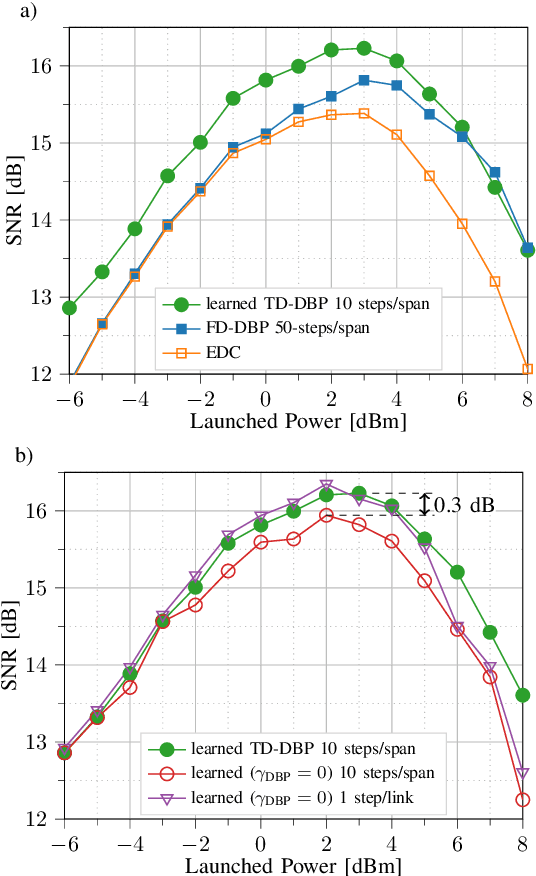
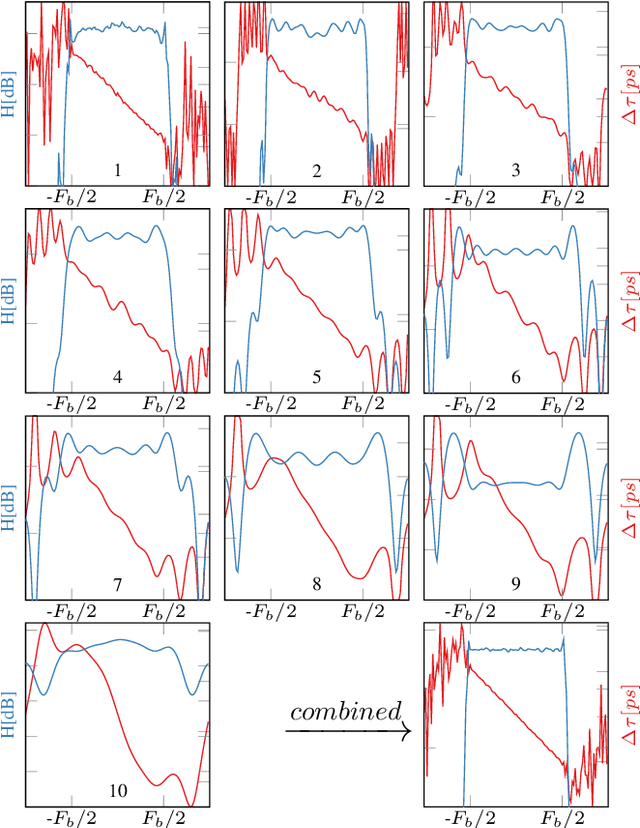

Abstract:We present the first experimental demonstration of learned time-domain digital back-propagation (DBP), in 64-GBd dual-polarization 64-QAM signal transmission over 1014 km. Performance gains were comparable to those obtained with conventional, higher complexity, frequency-domain DBP.
Concept and Experimental Demonstration of Optical IM/DD End-to-End System Optimization using a Generative Model
Dec 17, 2019


Abstract:We perform an experimental end-to-end transceiver optimization via deep learning using a generative adversarial network to approximate the test-bed channel. Previously, optimization was only possible through a prior assumption of an explicit simplified channel model.
End-to-End Optimized Transmission over Dispersive Intensity-Modulated Channels Using Bidirectional Recurrent Neural Networks
Jan 24, 2019



Abstract:We propose an autoencoding sequence-based transceiver for communication over dispersive channels with intensity modulation and direct detection (IM/DD), designed as a bidirectional deep recurrent neural network (BRNN). The receiver uses a sliding window technique to allow for efficient data stream estimation. We find that this sliding window BRNN (SBRNN), based on end-to-end deep learning of the communication system, achieves a significant bit-error-rate reduction at all examined distances in comparison to previous block-based autoencoders implemented as feed-forward neural networks (FFNNs), leading to an increase of the transmission distance. We also compare the end-to-end SBRNN with a state-of-the-art IM/DD solution based on two level pulse amplitude modulation with an FFNN receiver, simultaneously processing multiple received symbols and approximating nonlinear Volterra equalization. Our results show that the SBRNN outperforms such systems at both 42 and 84\,Gb/s, while training fewer parameters. Our novel SBRNN design aims at tailoring the end-to-end deep learning-based systems for communication over nonlinear channels with memory, such as the optical IM/DD fiber channel.
End-to-end Deep Learning of Optical Fiber Communications
Aug 03, 2018



Abstract:In this paper, we implement an optical fiber communication system as an end-to-end deep neural network, including the complete chain of transmitter, channel model, and receiver. This approach enables the optimization of the transceiver in a single end-to-end process. We illustrate the benefits of this method by applying it to intensity modulation/direct detection (IM/DD) systems and show that we can achieve bit error rates below the 6.7\% hard-decision forward error correction (HD-FEC) threshold. We model all componentry of the transmitter and receiver, as well as the fiber channel, and apply deep learning to find transmitter and receiver configurations minimizing the symbol error rate. We propose and verify in simulations a training method that yields robust and flexible transceivers that allow---without reconfiguration---reliable transmission over a large range of link dispersions. The results from end-to-end deep learning are successfully verified for the first time in an experiment. In particular, we achieve information rates of 42\,Gb/s below the HD-FEC threshold at distances beyond 40\,km. We find that our results outperform conventional IM/DD solutions based on 2 and 4 level pulse amplitude modulation (PAM2/PAM4) with feedforward equalization (FFE) at the receiver. Our study is the first step towards end-to-end deep learning-based optimization of optical fiber communication systems.
 Add to Chrome
Add to Chrome Add to Firefox
Add to Firefox Add to Edge
Add to Edge